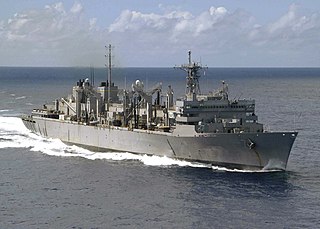
The fast combat support ship is a type of replenishment auxiliary ship. Different from traditional logistic ships, the fast combat support ship is designed with high speed to keep up with the carrier battle group/carrier strike group, while the multi-product station is capable of supplying all types of necessities for the fleet.

The Royal Fleet Auxiliary (RFA) is a naval auxiliary fleet owned by the UK's Ministry of Defence. It provides logistical and operational support to the Royal Navy and Royal Marines. The RFA ensures the Royal Navy is supplied and supported by providing fuel and stores through replenishment at sea, transporting Royal Marines and British Army personnel, providing medical care and transporting equipment and essentials around the world. In addition the RFA acts independently providing humanitarian aid, counter piracy and counter narcotic patrols together with assisting the Royal Navy in preventing conflict and securing international trade. They are a uniformed civilian branch of the Royal Navy staffed by British merchant sailors.

RFA Fort Austin is a retired British Fort Rosalie-class dry stores ship of the Royal Fleet Auxiliary.
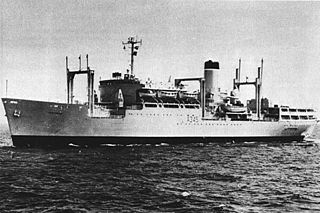
RFA Tarbatness (A345) was a fleet stores ship of the Royal Fleet Auxiliary.
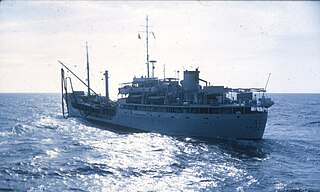
RFA Gold Ranger (A130) was a fleet support tanker of the Royal Fleet Auxiliary which first served in World War II.

Military Sealift Command (MSC) is an organization that controls the replenishment and military transport ships of the United States Navy. Military Sealift Command has the responsibility for providing sealift and ocean transportation for all US military services as well as for other government agencies. It first came into existence on 9 July 1949 when the Military Sea Transportation Service (MSTS) became solely responsible for the Department of Defense's ocean transport needs. The MSTS was renamed the Military Sealift Command in 1970.

Combat stores ships, or storeships, are ships used to store naval supplies. They are used to deliver supplies such as provisions and fuel to combat ships on extended deployments. The United States Navy operates the Sirius and Mars classes and the Royal Navy operates the Fort Rosalie and Fort Victoria classes. They carry the fleets's refrigerated stores, dry provisions, technical spares, general stores, fleet freight, mail and replacement personnel\specialists.Storeships should not be confused with fast combat support ships which are high speed auxiliary ships or tenders which provide maintenance support to flotillas.
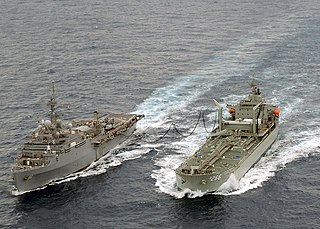
A replenishment oiler or replenishment tanker is a naval auxiliary ship with fuel tanks and dry cargo holds which can supply both fuel and dry stores during underway replenishment (UNREP) at sea. Many countries have used replenishment oilers.

USNS Arctic (T-AOE-8), formerly USS Arctic (AOE-8), is the third ship in the Supply class of fast combat support ships and is the fifth supply ship to carry the name of the region surrounding the North Pole.
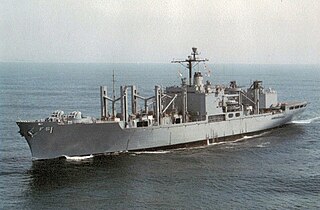
The Mars-class combat stores ships were a class of seven auxiliary vessels of the United States Navy. The ships were designed for underway replenishment, in support of carrier task force groups, carrying miscellaneous stores and munitions. Initially they carried no fuel oil or liquid cargo, but by the early 1990s the class was refitted with limited refuel capacities for F-76 fuel. None of the original seven ships originally commissioned by the US Navy remain in service. The Mars class was replaced by the Lewis and Clark-class dry cargo ships.

USS Mars (AFS‑1), the third United States Navy ship to bear the name, was laid down by the National Steel and Shipbuilding Company in San Diego, California, on 5 May 1962; launched on 15 June 1963, sponsored by Mrs. Clyde Doyle, widow of Representative Clyde Doyle of California; and commissioned at Long Beach Naval Shipyard on 21 December 1963.

USS Niagara Falls (AFS–3), a Mars-class combat stores ship, was the only ship of the United States Navy to be named after the City of Niagara Falls, New York. Commissioned into the US Navy on 29 April 1967, she served until September 1994, when she was transferred to the US Military Sealift Command to serve as USNS Niagara Falls (T-AFS-3). Assigned to the Naval Fleet Auxiliary Force, Far East, she served until 30 September 2008, when she was finally deactivated.

USNS Sirius was a Sirius-class combat stores ship of the United States Navy, named for Sirius (α Canis Majoris), the brightest star visible from Earth other than the Sun.

USS San Diego (AFS-6) was a Mars-class combat stores ship acquired by the U.S. Navy in 1968. She served the U.S. Atlantic Fleet until decommissioned in 1993. She then was redesignated as a United States Naval Ship, assigned to the Military Sealift Command, and served in a non-commissioned status with a mostly civilian crew as USNS San Diego (T-AFS-6) until 1997.
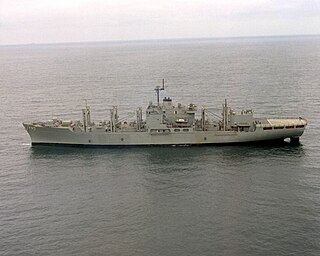
USS San Jose (AFS-7) was a Mars-class combat stores ship acquired by the U.S. Navy (USN) in 1970. She served as a Navy ship until November 1993, and was involved in the Vietnam War and the Persian Gulf War. The ship was transferred to the Military Sealift Command (MSC), and was redesignated USNS San Jose (T-AFS-7). As an MSC vessel, San Jose was involved in the INTERFET peacekeeping taskforce, the response to the December 2004 Indian Ocean tsunami, as well as the wars in Afghanistan and Iraq. The ship was deactivated in 2010, and was sold for scrap in 2013.
Saturn is a planet in the Solar System.
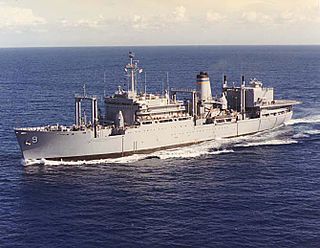
USNS Spica (T-AFS-9), was a combat stores ship acquired by the U.S. Navy from the United Kingdom in 1981. She participated in Operation Fiery Vigil to evacuate Clark Air Base personnel following the Mount Pinatubo Eruption in 1991. She served as part of the Military Sealift Command until she was deactivated in 2008.
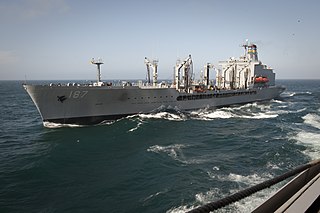
USNS Henry J. Kaiser (T-AO-187) is a United States Navy fleet replenishment oiler and the lead ship of her class. Her mission is to resupply U.S. Navy and allied ships at sea with fuel oil, jet fuel, lubricating oil, potable water, and dry and refrigerated goods, including food and mail.

USNS Medgar Evers (T-AKE-13) is a Lewis and Clark-class dry cargo ship of the United States Navy. As part of the Navy's Combat Logistics Force, her mission is to deliver ammunition, provisions, dry stores, refrigerated food, spare parts, potable water, and diesel and jet fuel to U.S. Navy and allied ships while at sea. The ship is named for civil rights movement activist Medgar Evers, a World War II veteran who was assassinated in 1963. The Navy announced the naming on 9 October 2009.
The Naval Fleet Auxiliary Force is a division of the US Navy. The 42 ships of the Military Sealift Command's Naval Fleet Auxiliary Force are the supply lines to U.S. Navy ships at sea. These ships provide virtually everything that Navy ships need, including fuel, food, ordnance, spare parts, mail and other supplies. NFAF ships enable the Navy fleet to remain at sea, on station and combat ready for extended periods of time. NFAF ships also conduct towing, rescue and salvage operations or serve as floating medical facilities. All NFAF ships are government owned and crewed by civil service mariners. Some of the ships also have a small contingent of Navy personnel aboard for operations support, supply coordination and helicopter operations.



















